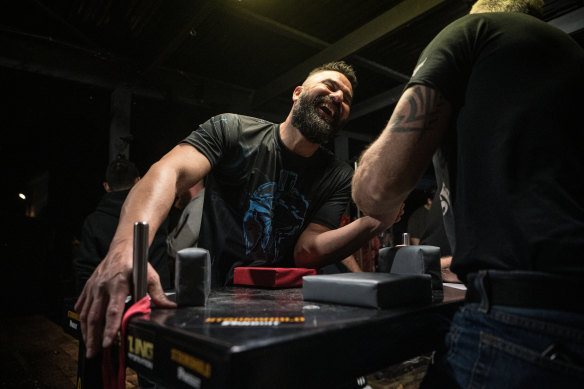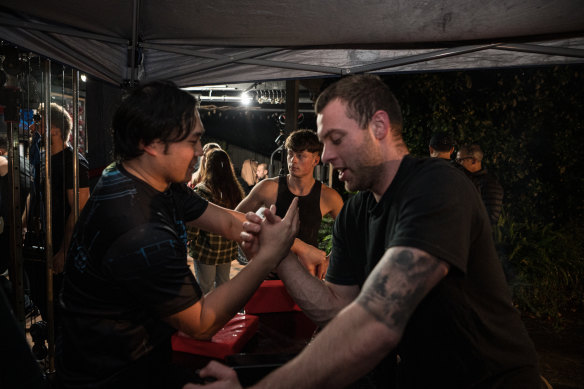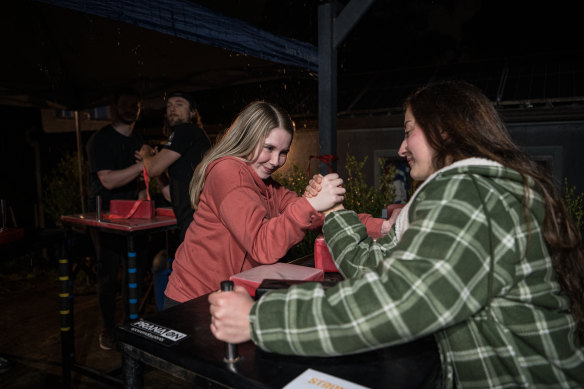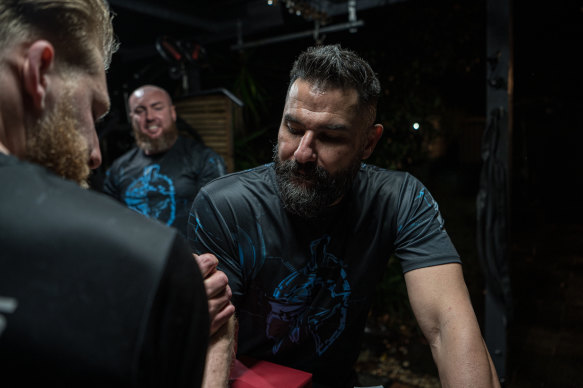Oz Caglar is fortunate to have understanding neighbours given the grunts and anguished cries emanating from his backyard.
Mostly brawny blokes face each other across a small table, shoulders braced, wrists straight and thumb knuckles exposed as they grip each other’s hand.

Sydney Spartans Armwrestling Club founder Oz Caglar hosts weekly training sessions the backyard of his home in North Rocks.Credit: Flavio Brancaleone
Biceps bulge and faces grimace as they try to pin their opponent’s hand to the table during a training session at the Sydney Spartans Armwrestling Club.
Caglar said arm-wrestling is not solely about strength, although his vice-like handshake deserves its own warning sign.
“Having strong developed tendons, especially in the hand and forearms can help you disable the power from someone who is a lot stronger,” he said.
“We have had big 120 kilogram-plus buff gym junkies come to training and be humbled by our 63-kilogram skinny arm-wrestler.”

Mario Tambakis said armwrestling requires more than just brute strength: “You need to be mentally strong.”Credit: Flavio Brancaleone
One of the club’s star competitors is probably the smallest.
A national lightweight arm-wrestling champion, Stephanie Vassallo describes herself as “a five-foot chick” who is often underestimated by opponents.
“A lot of people look at me and think they can flatten me because they’re bigger,” she said.
Physically, Mario Tambakis is the opposite: his arms look bigger than her torso thanks to 10 gym sessions a week.

Ella Sabey and Stephanie Vassallo at Sydney Spartans Armwrestling club training at North Rocks.Credit: Flavio Brancaleone
But he said: “Sometimes you do get your arse kicked by those pigeon-chested guys.”
Tambakis said arm-wrestling requires more than muscles.
“You need to be mentally strong,” he said. “You need to be physically strong, and I guess you also need to be smart or strategic.”
Caglar founded the club in 2015 and hosts weekly training sessions in the backyard of his home in North Rocks for up to 30 “pullers”.

Oz Caglar (right) said buff gym junkies have come to training and been “humbled by our 63-kilogram skinny arm-wrestler”.Credit: Flavio Brancaleone
“The concept of pulling is actually arm-wrestling because you want to pull your opponent towards you,” he said. “Most train during the week with very specific movements that mimic pulling.”
Competitors range in age from 12 to 64 and Caglar, a cybersecurity expert, said members come from as far as the Blue Mountains, Wollongong and Gosford and include lawyers, engineers, tradies and students.
About 150 arm-wrestlers from around Australia are expected to compete in the NSW Armwrestling Championships on July 13, with competitors divided by weight, gender and preferred hand.
Australian Armwrestling Federation president Phil Rasmussen has high hopes the sport, which is subject to anti-doping rules, will become an Olympic sport – perhaps for the 2028 Los Angeles games.
“As a traditional test of strength between two athletes dating back thousands of years, arm-wrestling aligns with the Olympic values of strength, unity and fair play,” he said.
The rules of arm-wrestling are simple: competitors must keep their elbows on a padded block at all times and pin their opponent’s hand on what Rasmussen calls the “pin pad” to win.
If an elbow lifts or slides off the pad, it is a foul.
“Two fouls result in a loss,” he said. “If hands slip apart during the match, the referee will apply a strap to ensure they stay bound until there is a pin.”
Rasmussen said arm-wrestlers typically use techniques such as the top roll, which focuses on hand control and leverage to weaken the opponent’s grip.
Tambakis’s preferred method, the hook, involves flexing the wrist and arm strength to pull his opponent in and drag them across the table to the pin pad.
The press, meanwhile, involves a competitor using their body weight and shoulder strength to press an opponent’s hand down to the pad.
Rasmussen became interested in competitive arm-wrestling after watching the documentary Pulling John about arm-wrestler John Brzenk.
“I scoured the internet but couldn’t find any arm-wrestling groups in Melbourne until I eventually stumbled across two guys who casually arm-wrestled in their garage on the weekend,” he said.
Within months, he had set up the official body for the sport in Australia, which runs competitions including the qualifier for the World Armwrestling Championships.
Celine Van Os was a spectator at an arm-wrestling event in 2016 when she stepped in to compete because there were only two women competitors.
“It’s a fascinating sport, there’s always new things to learn, practice, or improve upon which keeps training exciting and engaging,” she said.
A member of Melbourne’s House of Pain arm-wrestling club, Van Os said there were about 30 women competing in the sport – although they continued to be outnumbered by men.
“Training and competing in a strength-based sport has been really rewarding for myself and the women I train with,” she said. “I’m really excited about the future of female arm-wrestling.”
News, results and expert analysis from the weekend of sport sent every Monday. Sign up for our Sport newsletter.